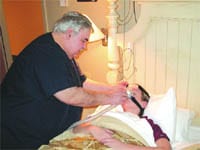‘Incident to’ and Supervision Requirements Billing for Services of Non-physician Practitioners – Part II
This is the second in our series of articles on utilization on non-physician practitioners (NPPs).
In the previous article (March 2005) we discussed two ways to bill for the services of a NPP. One way is to direct bill under the NPP’s name and provider identification number (PIN). The other way is to bill under a physician’s name and PIN. This is called ‘incident to’ billing. If billed under the NPP’s name and PIN, CMS (and some others) will only pay 85{06cf2b9696b159f874511d23dbc893eb1ac83014175ed30550cfff22781411e5} of the allowable fee. If billed ‘incident to,’ CMS will pay 100{06cf2b9696b159f874511d23dbc893eb1ac83014175ed30550cfff22781411e5} of the allowable fee. The difference of 15{06cf2b9696b159f874511d23dbc893eb1ac83014175ed30550cfff22781411e5} is not inconsequential when applying it to annual collections of $200,000 or more. There will be situations in which a NPP may have to direct bill. For this reason, you will want to get your NPPs enrolled with CMS and other payers as soon as possible.
It is important to note here that most payers other than CMS will pay 100{06cf2b9696b159f874511d23dbc893eb1ac83014175ed30550cfff22781411e5} of the allowable, even if direct billed. However, many payers will not credential NPPs to direct bill, so they have to bill ‘incident to’ in order to get paid.
In order to bill ‘incident to’ and get paid the 100{06cf2b9696b159f874511d23dbc893eb1ac83014175ed30550cfff22781411e5} allowable amount, certain criteria must be met. One of these criteria is the CMS supervision test. ‘Incident to’ is a CMS (Medicare) concept that means the NPP is providing a service that is integral but incidental to a physician’s professional service that is commonly rendered in physician offices and clinics. The physician must provide the initial service, i.e., he must see the patient during the initial visit, and must set up a plan of care (course of treatment).
The NPP may subsequently attend to the patient and bill under the physician’s name and PIN if properly supervised. If the patient comes in with a new presenting problem, the NPP must either direct bill (if allowed) or have the physician see the patient to establish a new treatment plan. Most other payers generally follow the CMS criteria but there may be some differences. For this reason, you should contact each payer to verify their position.
CMS has three levels of supervision: general, direct, and personal:
- General supervision means the service or procedure is furnished under the physician’s overall direction and control, but the physician’s presence is not required.
- Direct supervision in the office setting means the physician must be present in the office suite and immediately available to furnish assistance and direction. It does not mean that the physician must be present in the room when the service or procedure is performed.
- Personal supervision means a physician must be in attendance in the room during the performance of the service or procedure.
Patient encounters in the office generally require direct supervision although CMS uses the term ‘direct personal.’ CMS does not specify what is considered ‘present in the office suite,’ but it is generally considered met if the supervising doctor is on the same level in the same building and/or within shouting distance.
f the referring physician cannot be present in the office suite, another doctor of the group may do the supervising. In this case, however, the service must be billed incident to the supervising physician, not the referring physician. Services performed in a non-office setting, such as in the patient’s home or in an assisted living facility, must have personal supervision. General supervision is permitted for homebound patients in medically underserved areas designated as healthcare professional shortage areas.
Who can be a supervising physician? Any physician member of the practice, including leased or independent contractors. Non-employee physicians would have to make an assignment of benefits to the practice. Non-physician providers can also be supervising personnel (unless not allowed by the state scope of practice or by commercial payers), but would have to bill the service under their PIN, which means it would only be reimbursed at 85{06cf2b9696b159f874511d23dbc893eb1ac83014175ed30550cfff22781411e5} by CMS. Examples are audiologists, CNMs, NPs, PAs, CNSs, PTs, OTs, and clinical psychologists.
There are separate supervision guidelines for diagnostic testing which will be covered in the next article.
In addition to the supervision requirements, it is very important that the patient’s medical record clearly documents that the physician initially met with the patient and set up a plan of care. Without this, there is no basis to support incident to billing. The record should also document not only the NPP rendering the service, but also that the physician was present and supervising at the time of service. Finally, the medical record must document the medical necessity of the service billed for.
What is a ‘shared visit’? In certain instances, such as in a hospital, a doctor and a NPP from the same practice may both see a patient in the same day. If both practitioners have a face-to-face visit with the patient and if both document their service in the medical record, the visit can be either billed under the physician’s PIN (100{06cf2b9696b159f874511d23dbc893eb1ac83014175ed30550cfff22781411e5} allowable paid) or directly under the NPP’s PIN (85{06cf2b9696b159f874511d23dbc893eb1ac83014175ed30550cfff22781411e5} allowable paid) if allowed by the payer. Remember, you can’t bill incident to in a hospital. Both the physician and the NPP must be from the same group practice or employed by the same employer. Consultations and critical care services do not apply and cannot be billed as a shared visit.
James B. Calnan, CPA, is partner-in-charge of the Health Care Services Division of Longmeadow-based Meyers Brothers Kalicka, P.C., Certified Public Accountants and Business Consultants.




Comments are closed.